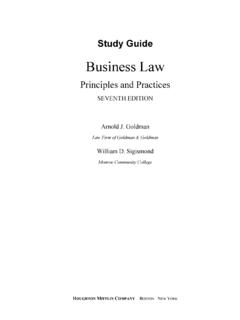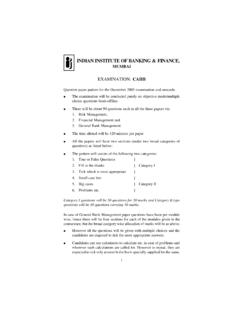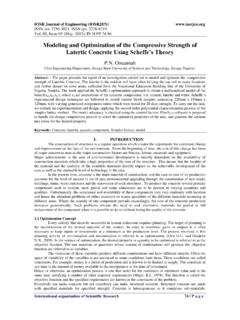Transcription of 9.3 THE SIMPLEX METHOD: MAXIMIZATION - …
1 494 CHAPTER 9 LINEAR PROGRAMMING. THE SIMPLEX METHOD: MAXIMIZATION . For linear programming problems involving two variables, the graphical solution method introduced in Section is convenient. However, for problems involving more than two variables or problems involving a large number of constraints, it is better to use solution methods that are adaptable to computers. One such method is called the SIMPLEX method, developed by George Dantzig in 1946. It provides us with a systematic way of examining the vertices of the feasible region to determine the optimal value of the objective function. We introduce this method with an example.
2 Suppose we want to find the maximum value of z 5 4x1 1 6x2, where x1 $ 0 and x2 $ 0, subject to the following constraints. 2x1 1 5x2 # 11. 2x1 1 5x2 # 27. 2x1 1 5x2 # 90. Since the left-hand side of each inequality is less than or equal to the right-hand side, there must exist nonnegative numbers s1, s2 and s3 that can be added to the left side of each equa- tion to produce the following system of linear equations. 2x1 1 5x2 1 s1 1 s2 1 s3 5 11. 2x1 1 5x2 1 s1 1 s2 1 s3 5 27. 2x1 1 5x2 1 s1 1 s2 1 s3 5 90. The numbers s1, s2 and s3 are called slack variables because they take up the slack in each inequality.
3 Standard Form of a A linear programming problem is in standard form if it seeks to maximize the objec- tive function z 5 c1x1 1 c2 x2 1 .. 1 cn xn subject to the constraints Linear Programming a11x1 1 a12x2 1 .. 1 a1nxn # b1. Problem a21x1 1 a22x2 1 .. 1 a2nxn # b2.. am1 x1 1 am2 x2 1 .. 1 amn xn # bm where xi $ 0 and bi $ 0. After adding slack variables, the corresponding system of constraint equations is a11x1 1 a12x2 1 .. 1 a1nxn 1 s1 5 b1. a21x1 1 a22x2 1 .. 1 a2nxn 1 s2 5 b2.. am1x1 1 am2x2 1 .. 1 amnxn 1 s m 5 bm where si $ 0. SECTION THE SIMPLEX METHOD: MAXIMIZATION 495. REMARK: Note that for a linear programming problem in standard form, the objective function is to be maximized, not minimized.
4 (Minimization problems will be discussed in Sections and ). A basic solution of a linear programming problem in standard form is a solution sx1, x2, .. , xn, s1, s2, .. , smd of the constraint equations in which at most m variables are nonzero the variables that are nonzero are called basic variables. A basic solution for which all variables are nonnegative is called a basic feasible solution. The SIMPLEX Tableau The SIMPLEX method is carried out by performing elementary row operations on a matrix that we call the SIMPLEX tableau. This tableau consists of the augmented matrix corre- sponding to the constraint equations together with the coefficients of the objective function written in the form 2c1x1 2 c2x2 2.
5 2 cnxn 1 s0ds1 1 s0ds2 1 .. 1 s0d sm 1 z 5 0. In the tableau, it is customary to omit the coefficient of z. For instance, the SIMPLEX tableau for the linear programming problem z 5 4x1 1 6x2 Objective function 2x1 1 5x2 1 s1 1 s2 1 s3 5 11. 2x1 1 5x2 1 s1 1 s2 1 s3 5 27. 2x1 1 5x2 1 s1 1 s2 1 s3 5 90. } Constraints is as follows. Basic x1 x2 s1 s2 s3 b Variables 21 1 1 0 0 11 s1. 1 1 0 1 0 27 s2. 2 5 0 0 1 90 s3. 24 26 0 0 0 0.. Current z value For this initial SIMPLEX tableau, the basic variables are s1, s2, and s3, and the nonbasic variables (which have a value of zero) are x1 and x2. Hence, from the two columns that are farthest to the right, we see that the current solution is x1 5 0, x2 5 0, s1 5 11, s2 5 27, and s3 5 90.
6 This solution is a basic feasible solution and is often written as sx1, x2, s1, s2, s3d 5 s0, 0, 11, 27, 90d. 496 CHAPTER 9 LINEAR PROGRAMMING. The entry in the lower right corner of the SIMPLEX tableau is the current value of z. Note that the bottom row entries under x1 and x2 are the negatives of the coefficients of x1 and x2 in the objective function z 5 4x1 1 6x2. To perform an optimality check for a solution represented by a SIMPLEX tableau, we look at the entries in the bottom row of the tableau. If any of these entries are negative (as above), then the current solution is not optimal. Pivoting Once we have set up the initial SIMPLEX tableau for a linear programming problem, the sim- plex method consists of checking for optimality and then, if the current solution is not op- timal, improving the current solution.
7 (An improved solution is one that has a larger z-value than the current solution.) To improve the current solution, we bring a new basic variable into the solution we call this variable the entering variable. This implies that one of the current basic variables must leave, otherwise we would have too many variables for a basic solution we call this variable the departing variable. We choose the entering and departing variables as follows. 1. The entering variable corresponds to the smallest (the most negative) entry in the bottom row of the tableau. 2. The departing variable corresponds to the smallest nonnegative ratio of biyaij, in the column determined by the entering variable.
8 3. The entry in the SIMPLEX tableau in the entering variable's column and the departing variable's row is called the pivot. Finally, to form the improved solution, we apply Gauss-Jordan elimination to the column that contains the pivot, as illustrated in the following example. (This process is called pivoting.). EXAMPLE 1 Pivoting to Find an Improved Solution Use the SIMPLEX method to find an improved solution for the linear programming problem represented by the following tableau. Basic x1 x2 s1 s2 s3 b Variables 21 1 1 0 0 11 s1. 1 1 0 1 0 27 s2. 2 5 0 0 1 90 s3. 24 26 0 0 0 0. The objective function for this problem is z 5 4x1 1 6x2.
9 SECTION THE SIMPLEX METHOD: MAXIMIZATION 497. Solution Note that the current solution sx1 5 0, x2 5 0, s1 5 11, s2 5 27, s3 5 90d corresponds to a z value of 0. To improve this solution, we determine that x2 is the entering variable, because 26 is the smallest entry in the bottom row. Basic x1 x2 s1 s2 s3 b Variables 21 1 1 0 0 11 s1. 1 1 0 1 0 27 s2. 2 5 0 0 1 90 s3. 24 26 0 0 0 0.. Entering To see why we choose x2 as the entering variable, remember that z 5 4x1 1 6x2. Hence, it appears that a unit change in x2 produces a change of 6 in z, whereas a unit change in x1. produces a change of only 4 in z. To find the departing variable, we locate the bi's that have corresponding positive elements in the entering variables column and form the following ratios.
10 11 27 90. 5 11, 5 27, 5 18. 1 1 5. Here the smallest positive ratio is 11, so we choose s1 as the departing variable. Basic x1 x2 s1 s2 s3 b Variables 21 1 1 0 0 11 s1 Departing 1 1 0 1 0 27 s2. 2 5 0 0 1 90 s3. 24 26 0 0 0 0.. Entering Note that the pivot is the entry in the first row and second column. Now, we use Gauss- Jordan elimination to obtain the following improved solution. Before Pivoting After Pivoting 21 21. 3 4 3 4. 1 1 0 0 11 1 1 0 0 11. 1 1 0 1 0 27 2 0 21 1 0 16. 2 5 0 0 1 90 7 0 25 0 1 35. 24 26 0 0 0 0 210 0 6 0 0 66. The new tableau now appears as follows. 498 CHAPTER 9 LINEAR PROGRAMMING.












